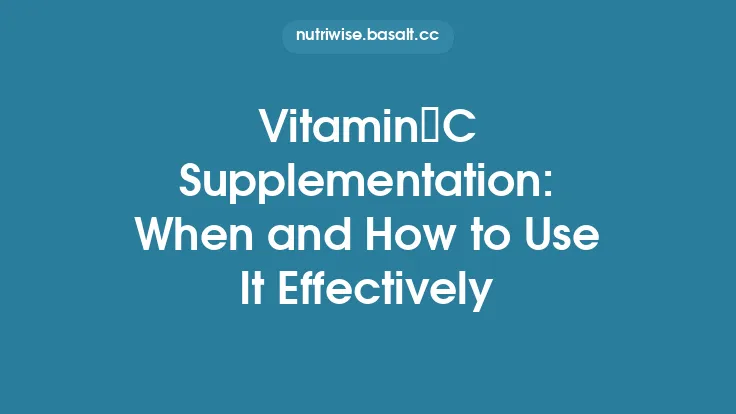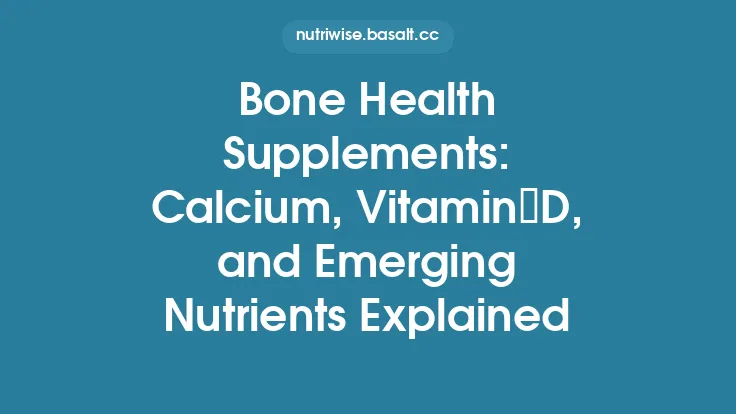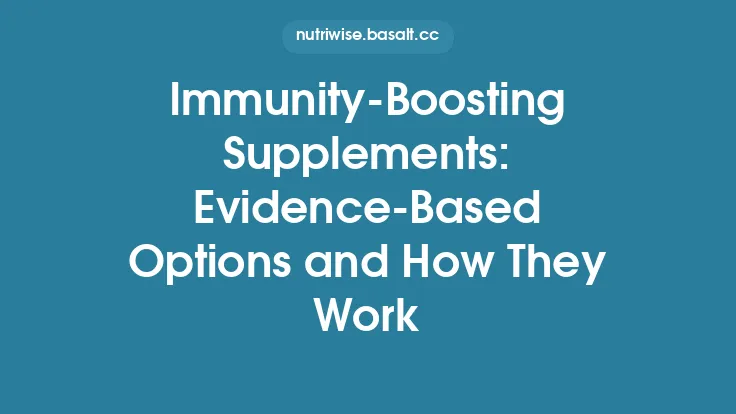When you start taking a new vitamin, mineral, herb, or specialty supplement, the excitement of “optimizing” your health can quickly turn into confusion. The supplement aisle is filled with products that promise everything from better sleep to sharper focus, and many people end up stacking several of them in the hope of achieving a synergistic boost. However, unlike the straightforward additive effect you might expect, many nutrients and botanicals interact in ways that can blunt benefits, create imbalances, or even produce toxicity. Understanding how these interactions occur, recognizing the most common hazardous pairings, and implementing a systematic approach to evaluate your own regimen are essential steps to keep your supplement routine safe and effective.
Understanding the Mechanisms Behind Supplement Interactions
Supplement–supplement interactions are rooted in basic biochemistry. When two or more compounds are ingested together, they can influence each other’s absorption, distribution, metabolism, or excretion (the ADME framework). The most frequent mechanisms include:
| Mechanism | How It Works | Typical Outcome |
|---|---|---|
| Competitive Absorption | Two nutrients vie for the same transporter or binding site in the gut (e.g., iron and calcium share the DMT1 transporter). | Reduced bioavailability of one or both agents. |
| Enzyme Induction/Inhibition | One supplement modulates cytochrome P450 enzymes or phase‑II conjugation pathways, altering the metabolic rate of another (e.g., high‑dose curcumin inhibits UGT enzymes). | Accumulation or rapid clearance, leading to sub‑therapeutic or toxic levels. |
| pH‑Dependent Solubility | Certain minerals dissolve optimally at specific gastric pH levels; co‑administration of acid‑suppressing agents or other supplements can shift pH. | Impaired dissolution and absorption. |
| Chelation and Complex Formation | Minerals can bind to each other forming insoluble complexes (e.g., zinc and copper forming a chelate). | Decreased absorption of the chelated mineral. |
| Synergistic Toxicity | Two compounds act on the same physiological pathway, amplifying an effect beyond safe limits (e.g., vitamin A and retinol‑derived carotenoids). | Heightened risk of organ‑specific toxicity. |
| Altered Transport Proteins | Some botanicals up‑ or down‑regulate transport proteins like P‑glycoprotein, affecting the cellular uptake of other supplements. | Variable intracellular concentrations. |
These mechanisms are not mutually exclusive; a single pairing can involve multiple pathways simultaneously, compounding the risk.
Common Categories of Hazardous Combinations
While the universe of possible pairings is vast, several categories recur in clinical observations and research literature. Recognizing these groups helps you quickly screen a supplement stack for red flags.
1. Fat‑Soluble Vitamin Overlap
- Vitamin A + Preformed Retinol Sources – High‑dose beta‑carotene, cod liver oil, and retinyl palmitate all feed the retinoid pool. Excessive intake can precipitate hypervitaminosis A, manifesting as hepatotoxicity, intracranial hypertension, and teratogenic risk (the latter is a concern for pregnant individuals, but the toxicity itself is relevant to the general population).
- Vitamin D + High‑Dose Calcium – Vitamin D dramatically enhances intestinal calcium absorption. When both are taken in supraphysiologic doses, serum calcium can rise to hypercalcemic levels, leading to nephrolithiasis and vascular calcification.
2. Mineral Competition
- Iron + Calcium – Calcium interferes with non‑heme iron absorption by competing for the DMT1 transporter and by forming insoluble complexes.
- Zinc + Copper – High zinc intake induces metallothionein, which preferentially binds copper, reducing copper absorption and potentially causing a functional copper deficiency (anemia, neutropenia).
- Magnesium + Calcium (High Doses) – Both minerals share the same transport pathways; excessive simultaneous dosing can lead to imbalanced serum ratios, affecting neuromuscular excitability and bone remodeling.
3. Herb–Herb Potentiation
- St. John’s Wort + 5‑HTP or L‑Tryptophan – Both increase serotonergic activity. Their combination can push serotonin levels into a range associated with serotonin syndrome, even without prescription drugs.
- Ginkgo Biloba + Ginseng – Both have mild antiplatelet effects; together they may increase bleeding risk, especially in individuals with underlying coagulopathies.
- Kava + Valerian – Both act on GABAergic pathways, potentially leading to excessive sedation and, in rare cases, hepatotoxicity due to overlapping metabolic pathways.
4. Antioxidant Overload
- High‑Dose Vitamin C + Vitamin B12 – Vitamin C can reduce the cobalt center of cyanocobalamin, converting it to an inactive form.
- Multiple High‑Dose Antioxidants (Vitamin E, Selenium, Coenzyme Q10) – While each is safe at recommended levels, megadoses can paradoxically act as pro‑oxidants, especially when combined, increasing oxidative stress rather than mitigating it.
5. Electrolyte Imbalance
- Potassium + Sodium Bicarbonate – Sodium bicarbonate can shift potassium intracellularly, while supplemental potassium raises extracellular levels; the net effect can cause unpredictable serum potassium fluctuations.
- Boron + Calcium – Boron influences calcium metabolism; excessive boron may exacerbate hypercalcemia when calcium supplements are also high.
Biochemical Pathways That Amplify Risk
Delving deeper into the molecular underpinnings clarifies why certain pairings are especially perilous.
a. Cytochrome P450 (CYP) Modulation
Many botanicals (e.g., grapefruit flavonoids, curcumin, resveratrol) inhibit CYP3A4, CYP2C9, or CYP1A2. When two CYP‑modulating supplements are taken together, the inhibition can become additive, leading to dramatically reduced clearance of co‑administered nutrients that are CYP substrates (e.g., certain forms of vitamin D). The result is an unexpected surge in active metabolite concentrations.
b. Phase‑II Conjugation Saturation
Glutathione‑S‑transferase (GST) and UDP‑glucuronosyltransferase (UGT) enzymes handle the conjugation of phenolic compounds (e.g., flavonoids, catechins). High intake of multiple phenolic-rich supplements can saturate these pathways, causing accumulation of reactive intermediates that may damage hepatic cells.
c. Transporter Competition (e.g., SLC Family)
Solute carrier (SLC) transporters such as SLC30A10 (zinc transporter) and SLC39A8 (manganese transporter) have limited capacity. Overloading the system with high doses of zinc and manganese simultaneously can lead to competitive inhibition, resulting in deficient intracellular manganese despite adequate intake, which may affect enzymatic processes like superoxide dismutase activity.
d. Hormone‑Mimicking Pathways
Phytoestrogens (e.g., soy isoflavones) and certain adaptogens (e.g., ashwagandha) can bind estrogen receptors. When combined with high‑dose vitamin D, which also modulates estrogen receptor expression, there can be an amplified hormonal effect, potentially influencing bone turnover and lipid metabolism.
Assessing Your Personal Supplement Regimen
A systematic audit of what you’re taking is the cornerstone of safety.
- Create a Master List
- Write down every product, including multivitamins, single‑nutrient pills, herbal extracts, amino‑acid powders, and “proprietary blends.”
- Note the brand, dosage per serving, frequency, and form (tablet, capsule, liquid, powder).
- Identify Overlapping Ingredients
- Use a spreadsheet to flag nutrients that appear in more than one product.
- Pay special attention to fat‑soluble vitamins, minerals with known competition, and botanicals with overlapping mechanisms.
- Calculate Total Daily Intake
- Convert all dosages to a common unit (e.g., mg, µg, IU).
- Compare the sum to established Tolerable Upper Intake Levels (ULs) from authoritative bodies (e.g., Institute of Medicine, EFSA). Exceeding ULs is a strong indicator of potential risk.
- Map Mechanistic Interactions
- For each pair, ask: *Do they share a transporter? Do they affect the same metabolic enzyme? Do they act on the same physiological pathway?*
- If the answer is “yes,” note the interaction type (absorption, metabolism, toxicity).
- Consider Timing and Formulation
- Some interactions are mitigated by spacing doses (e.g., taking iron and calcium 2–3 hours apart).
- Lipid‑based formulations (softgels) may enhance absorption of fat‑soluble vitamins, altering the effective dose compared to a dry tablet.
- Document Any Adverse Symptoms
- Even subtle changes—headaches, gastrointestinal upset, unusual fatigue—should be recorded. Patterns may reveal hidden interactions.
Practical Strategies to Prevent Dangerous Overlaps
After the audit, apply these evidence‑based tactics to keep your stack safe.
1. Prioritize Whole‑Food Sources
- Whenever possible, obtain nutrients from diet rather than isolated supplements. Whole foods provide a balanced matrix that naturally limits excessive intake.
2. Adopt a “One‑Nutrient‑At‑a‑Time” Approach
- Introduce a new supplement only after a 2‑week trial period, monitoring for side effects. This isolates the variable and simplifies attribution.
3. Separate Competing Minerals
- Schedule calcium‑rich products (e.g., calcium carbonate) at breakfast, and iron‑rich products (e.g., ferrous sulfate) at dinner, with at least a 2‑hour gap.
4. Use Targeted Formulations
- Choose chelated minerals (e.g., zinc picolinate) that have higher bioavailability and lower propensity to interfere with other minerals.
5. Mind the Upper Limits
- If total intake approaches 80 % of a UL, consider reducing or eliminating one source. The safety margin shrinks dramatically beyond this point.
6. Leverage Timing for Enzyme Modulation
- For botanicals known to inhibit CYP enzymes (e.g., curcumin), take them at a different time of day than other supplements that rely on those enzymes for activation.
7. Stay Informed on Formulation Changes
- Manufacturers may alter ingredient concentrations without prominent notice. Periodically re‑review product labels.
8. Utilize Professional Guidance
- While this article focuses on supplement‑supplement dynamics, a qualified nutritionist or dietitian can provide personalized analysis without venturing into medication territory.
Tools and Resources for Ongoing Safety Monitoring
| Resource | What It Offers | How to Use It |
|---|---|---|
| Supplement Fact‑Check Databases (e.g., Labdoor, ConsumerLab) | Independent testing results, label accuracy, contaminant screening. | Verify that the product contains the claimed amount of each ingredient. |
| Nutrient Interaction Apps (e.g., Nutrient Interaction Checker, iHerb’s interaction tool) | Automated alerts for known supplement‑supplement clashes. | Input your supplement list; review flagged interactions and suggested spacing. |
| Scientific Literature Search Engines (PubMed, Google Scholar) | Access to peer‑reviewed studies on specific nutrient interactions. | Search terms like “vitamin D calcium interaction” to understand dose‑response data. |
| UL Reference Tables (NIH Office of Dietary Supplements, EFSA) | Official upper intake levels for vitamins and minerals. | Compare your total daily intake against these benchmarks. |
| Spreadsheet Templates (available from nutrition societies) | Pre‑built columns for supplement name, dose, frequency, and interaction notes. | Populate with your regimen; use conditional formatting to highlight totals exceeding ULs. |
Regularly revisiting these tools—especially after adding a new product or changing dosages—helps maintain a dynamic safety net.
Case Illustrations of Problematic Pairings
Case 1: The “Bone Health” Stack
Supplements: Calcium carbonate 1,200 mg, Vitamin D3 5,000 IU, Magnesium glycinate 400 mg, Vitamin K2 (MK‑7) 200 µg.
Issue: The calcium dose alone approaches the UL (2,500 mg for adults). Adding high‑dose vitamin D dramatically increases calcium absorption, pushing serum calcium toward hypercalcemic ranges. Simultaneous magnesium at 400 mg can compete for the same transporters, reducing calcium uptake in the gut but also potentially causing a transient magnesium deficiency if the body prioritizes calcium.
Resolution: Reduce calcium to 800 mg, keep vitamin D at 2,000 IU (still within safe limits for most adults), and separate magnesium intake by taking it at bedtime, away from calcium. Monitor serum calcium after 4 weeks.
Case 2: The “Energy Boost” Cocktail
Supplements: St. John’s Wort 300 mg, 5‑HTP 100 mg, L‑Tryptophan 500 mg, Rhodiola rosea extract 200 mg.
Issue: St. John’s Wort and 5‑HTP both elevate serotonergic activity. Adding L‑tryptophan, a serotonin precursor, creates a triple‑hit on the serotonin pathway, raising the risk of serotonin syndrome (symptoms: agitation, tremor, hyperreflexia).
Resolution: Choose either St. John’s Wort *or* the tryptophan‑based supplements, not both. If mood support is the goal, a single agent at a moderate dose with careful monitoring is safer.
Case 3: The “Antioxidant Overload” Regimen
Supplements: Vitamin C 2,000 mg, Vitamin E (d‑α‑tocopherol) 400 IU, Selenium 200 µg, Coenzyme Q10 300 mg.
Issue: High doses of multiple antioxidants can shift the redox balance, paradoxically generating reactive oxygen species (ROS) through pro‑oxidant mechanisms, especially in the presence of metal ions like iron.
Resolution: Scale vitamin C to 500 mg, vitamin E to 200 IU, and keep selenium at 100 µg (the UL). Maintain a balanced diet rich in natural antioxidants rather than relying on megadoses.
Future Directions in Supplement Interaction Research
The field is evolving rapidly, driven by advances in omics technologies and data analytics.
- Metabolomics: High‑throughput profiling of blood metabolites after supplement ingestion can reveal subtle interaction signatures that traditional clinical labs miss.
- Pharmacogenomics of Nutrients: Genetic polymorphisms in transporters (e.g., SLC30A10) and metabolic enzymes (e.g., CYP2C9) influence individual susceptibility to interactions, paving the way for personalized supplement regimens.
- Artificial Intelligence‑Powered Interaction Databases: Machine‑learning models trained on published studies and adverse event reports can predict previously undocumented clashes, offering pre‑emptive alerts to consumers and clinicians.
- Standardized Reporting of Supplement Trials: Greater uniformity in how studies disclose dosage forms, timing, and co‑administered nutrients will improve meta‑analyses and the reliability of interaction guidelines.
Staying attuned to these developments will empower consumers to make evidence‑based decisions as the science matures.
Bottom line: While supplements can fill nutritional gaps and support specific health goals, the chemistry of the human body does not always accommodate a free‑for‑all approach. By understanding the underlying mechanisms, recognizing high‑risk pairings, systematically evaluating your own regimen, and employing practical timing and dosage strategies, you can enjoy the benefits of supplementation without stepping into the danger zone of harmful interactions. Regularly revisiting your stack with reliable tools and staying informed about emerging research will keep your supplement journey both safe and effective.





